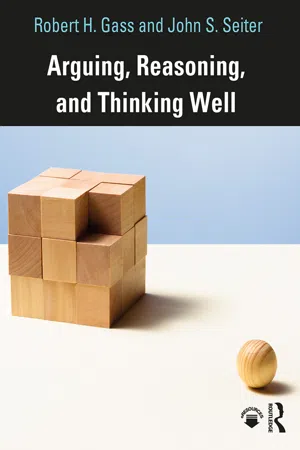Languages & Linguistics
Deduction
Deduction in linguistics refers to the process of drawing specific conclusions from general principles or premises. It involves reasoning from the general to the specific, often used in language analysis to make inferences about grammatical rules, sentence structures, and meaning. Deductive reasoning is fundamental to understanding and formulating linguistic theories and hypotheses.
Written by Perlego with AI-assistance
Related key terms
3 Key excerpts on "Deduction"
- eBook - ePub
- W. James Potter(Author)
- 2019(Publication Date)
- SAGE Publications, Inc(Publisher)
Chapter 7 Deducing: Reasoning with Logic from General Principles- I. The Deduction Algorithm
- Step 1: Begin With an Observation
- Step 2: Identify a Relevant General Principle
- Step 3: Use the Two Premises to Reason Logically to a Conclusion
- II. Heuristics
- Heuristic 1: Probability Premise
- Heuristic 2: Conditional Reasoning
- III. Avoiding Traps
- Trap 1: Faulty Major Premise
- Trap 2: Irrelevant Major Premise
- Trap 3: Too Complex a Major Premise Is Needed
- Trap 4: Conditional Reasoning
- Trap 5: Irrational Reasoning
- Trap 6: Unwillingness to Build Knowledge Structures
- IV. Chapter Review
- Exercises
Deduction is the skill of using a few premises to reason logically toward a conclusion. The basic procedure of Deduction follows a reasoning process in the form of a syllogism, which is a set of three statements. The first statement in the set is called the major premise ; it is usually a general principle or rule. The second statement is called the minor premise ; it is usually an observation. The third statement is the reasoned conclusion . We use logic to see if the observation fits the rule and then derive the conclusion.Perhaps the most familiar example of a syllogism is the one that uses the following two premises: (1) All men are mortal and (2) Socrates is a man. From this we can conclude that Socrates is mortal. The first premise is the major one; that is, it states a general proposition. The second premise is the minor one; that is, it provides information about something specific (in this case, a specific person) in a way that relates it to the major premise. Using logic, we see that the observation in the second premise fits the rule in the first premise and we conclude that Socrates is mortal.Deduction is the skill that the fictional detective Sherlock Holmes employed so successfully to make sense of clues and solve crimes. He knew a great deal about the physical world and about human behavior; this knowledge was his bank of major premises. He had keen powers of observation, so he was able to recognize clues that were the most relevant to solving a crime; his observations were his minor premises. When Sherlock Holmes found a clue (such as a scratch on a walking cane, mud on someone’s shoes, or the gardener taking walks in the middle of the night), he had a minor premise (the second statement in his syllogisms). He then searched his knowledge bank for a relevant general principle that could be used to explain the minor premise; this general principle became his major premise (the first statement in his syllogisms). He then used the general principle to explain the clue and this produced a conclusion. To Sherlock Holmes, this process of logical reasoning uses syllogisms. To us readers, he appeared to be a genius in his crime-solving ability but as he often said, “It’s elementary!” meaning that this was simple to him. And yes, the process of logical reasoning with a syllogism was easy for Sherlock Holmes; what was difficult was acquiring all the general principles and making good observations. - eBook - ePub
- Philip N. Johnson-Laird(Author)
- 2013(Publication Date)
- Psychology Press(Publisher)
According to this claim, Deduction is the prerogative of mathematicians and logicians. It seldom, if ever, occurs in everyday thought. This claim is exaggerated. The railway porter who saw Wittgenstein’s colleague running after the train provides us with a typical case of everyday Deduction. The real importance of Deduction, however, is demonstrated by deductive failures. The engineers in charge at the Chernobyl power plant, for example, persisted in trying to carry out the experiment that led to the disaster even when it was easy to infer that it was impossible to do so because the turbine was rotating too slowly for the test to be conducted (see Medvedev, 1990). The human cost of this deductive failure was high: the deaths of many people, and the release of radiation 10 times that of the bomb dropped on Hiroshima. Deduction is a crucial form of everyday thought, and we can all be placed at risk by the sorts of errors that I have described, especially the failure to envisage alternative possibilities compatible with the facts. What is true, however, is that human reasoners are not usually interested in validity for its own sake. Their goal is to reach conclusions that are true and useful. They often lack sufficient information to reach a valid conclusion, and so are forced to go beyond the given information and to make an induction. The mental machinery underlying induction, as I show in the next chapter, is closely related to the mechanism for Deduction. - eBook - ePub
- Robert Gass, John Seiter(Authors)
- 2019(Publication Date)
- Routledge(Publisher)
necessarily follows from the premises.In this chapter we examine such reasoning. After exploring Deduction’s applicability to everyday life, you will learn about its role in a variety of fields and contexts. Next, we will look at rules for testing the validity of syllogisms, which are one of the most common types of deductive reasoning. But first, let’s take a closer look at the difference between inductive and deductive reasoning.Deductive Versus Inductive Reasoning: A Whole Different AnimalAs we learned in previous chapters, inductive reasoning deals with probabilities. Returning to a Sherlock Holmes example, in The Hound of the Baskervilles (Doyle, 1902), Holmes inferred that whoever mailed a letter made of cut and pasted letters must be well educated because:the utmost pains have been taken to remove all clues. The address, you observe, is printed in rough characters. But The Times is a paper which is seldom found in any hands but those of the highly educated. We may take it, therefore, that the letter was composed by an educated man who wished to pose as an uneducated one. (p. 32)However, the conclusion doesn’t necessarily follow from the assumptions as it would if deductive reasoning were being used. A less-educated person could have found a copy of the newspaper lying about on a bus, or a train, or in a pub. Deductive reasoning deals with certainties. To see why, let’s examine a common type of deductive argument, known as a categorical syllogism , which looks like this:Figure 11.1 Caught up in a logical quandary. Paul Noth, cartoonbank.com , 2010-09-13, TCB-34912.© Paul Noth/The New Yorker Collection/www.cartoonbank.com .Premise #1: All tortoises are vegetarians. Premise #2: Bessie is a tortoise. Conclusion: Therefore, Bessie is a vegetarian.As you can see, a categorical syllogism has two premises followed by a conclusion. If both premises are true, the conclusion is a sure thing. In this case, Bessie is a vegetarian, no doubt about it.
Learn about this page
Index pages curate the most relevant extracts from our library of academic textbooks. They’ve been created using an in-house natural language model (NLM), each adding context and meaning to key research topics.


